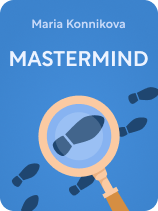

This article is an excerpt from the Shortform book guide to "Mastermind" by Maria Konnikova. Shortform has the world's best summaries and analyses of books you should be reading.
Like this article? Sign up for a free trial here.
How does Sherlock Holmes notice pertinent details? What if you could develop similar abilities?
In Mastermind, Maria Konnikova explores the foundations of Sherlock Holmes’s observation skills. She reveals how keen awareness and conscious control of our mental processes can enhance our ability to pick up on crucial details in our environment.
Read on to discover practical strategies for sharpening your own observational prowess and avoiding common pitfalls that cloud perceptions.
Sherlock Holmes’s Observation Skills
Sherlock Holmes’s observation skills are legendary. His keen eye for detail enables him to notice subtle clues that escape the notice of others. Konnikova suggests that the key to Holmes’s ability is his continual, mindful awareness of his mental processes and environment. His heightened awareness allows him to objectively take in all the evidence, ensuring that he doesn’t overlook crucial details or allow irrelevant distractions to mislead him.
This mindful approach is critical to his investigative success because his observations directly influence the information he retrieves from his memory, how he interprets the evidence, and his subsequent deductions. Likewise, Konnikova points out that your observations impact how you interpret and judge your environment, which in turn influences all your subsequent thoughts, decisions, and behaviors. We’ll now explain how the autopilot mode of thinking interferes with accurate observation and how you can consciously control what you observe.
Autopilot Mode Obstructs Accurate Observation
In contrast to Holmes’s mindful approach, operating on autopilot predisposes you to cognitive shortcuts that prioritize quick, effortless perception at the expense of accuracy. Konnikova explains that these shortcuts essentially filter your perceptions, making it impossible to objectively observe your environment. This leads you to base all your subsequent thoughts, decisions, and behaviors on skewed or incomplete observations.
According to Konnikova, several factors make you more susceptible to cognitive shortcuts and inaccurate observations.: distractions, priming, environmental conditions, your internal state, and biases. Let’s explore these in detail.
Factor 1) Distractions
Konnikova argues that distractions make it impossible to focus on or accurately observe anything. As a result, you overlook details in your environment. For example, while multitasking in a grocery store—talking on your phone and scanning the shelves—you might overlook a “Caution: Wet Floor” sign, resulting in a preventable accident. (Shortform note: Mihaly Csikszentmihalyi (Flow) suggests that you’re more prone to distractions when you feel dissatisfied. He explains that when you don’t value what you’re experiencing, you find it difficult to focus your attention on the present moment. However, your mind wants to focus on something, so it seeks external stimulation to occupy your thoughts.)
Factor 2) Priming
Konnikova suggests that priming—where recent stimuli narrow your focus—compels you to notice details that align with those stimuli and ignore those that don’t. For example, after seeing an advertisement for a specific car model, you start noticing that car model more frequently, while other models fade into the background.
(Shortform note: Priming is a type of subconscious manipulation often used in marketing and sales. For example, restaurants prime customers to want Italian wine by playing Italian music in the background—customers don’t consciously think they want Italian wine to go with the music, but they notice that part of the menu because of it. However, after several studies failed to replicate earlier findings about the impact of priming, some psychologists believe that its effects on perception are more limited than previously thought.)
Factor 3) Environmental Conditions
According to Konnikova, environmental conditions influence what you notice. For example, a gloomy day might dim your perception of your surroundings, causing you to miss the vibrant colors of a street mural that would usually catch your eye on a sunnier day.
Factor 4) Your Internal State
Konnikova explains that internal factors such as your mood or physical state skew your perception of events. For example, when you feel positive and energetic, you’re more likely to pick up on useful information in a work meeting. On the other hand, when you feel tired or unwell, you’re more likely to perceive that same meeting as banal and fail to note valuable insights.
(Shortform note: While Konnikova distinguishes between environmental and internal factors, Brianna Wiest (101 Essays That Will Change the Way You Think) argues that internal factors directly influence how you interpret and perceive your environment. For example, if you’re feeling upbeat, you might interpret weather that others perceive as gloomy as pleasantly cool and refreshing, and this positive interpretation might direct your attention to the vibrant colors of the street mural.)
Factor 5) Biases
According to Konnikova, biases stemming from entrenched stereotypes and past experiences lead you to only observe details that fit your preconceived notions and ignore any evidence that doesn’t fit. For example, if you believe that bankers are corrupt, you might only notice financial scandals and disregard reports of bankers working ethically. (Shortform note: Jennifer Eberhardt (Biased) explains that biases are the product of your natural impulse to divide all your thoughts, feelings, and experiences into categories. You unconsciously rely on these categories to make sense of the world—instead of observing every detail about a person or situation, you make assumptions about them based on their category, and these assumptions define what you notice.)
How to Consciously Control What You Observe
Konnikova suggests that you can overcome the influence of cognitive shortcuts and make more accurate observations by adopting a three-part strategy: Define your purpose, engage all your senses, and recognize and challenge cognitive shortcuts.
Strategy 1) Define Your Purpose
Begin by clearly defining the purpose of your observation. Konnikova explains that this intentional focus instructs your brain to consciously filter stimuli based on your objectives. This makes it easier for you to notice what’s relevant and ignore what’s not. For example, you define improving customer satisfaction as the purpose of your observation and choose to zero in on customer interactions and feedback mechanisms.
(Shortform note: The authors of Critical Thinking, Logic & Problem Solving suggest that you can define your purpose by identifying questions that need answering. They add that using neutral language to form questions can help you to objectively view all available information. For example, asking, “Why are our customers dissatisfied?” might focus your attention only on instances of poor service. On the other hand, asking a neutral question such as, “What factors influence customer retention?” may help you notice all aspects of customer interaction, giving you a comprehensive overview of the situation.)
Strategy 2) Engage All Your Senses
With your purpose in mind, bring all of your senses into play to observe your environment. Konnikova says that a multisensory approach enables you to consciously capture nuances and details that you might otherwise overlook. For example, the purpose of your observation is to gauge your child’s mood. Instead of just asking them how their day was and listening to their verbal response, observe their body language and energy levels, notice if they’re tense or relaxed when you hug them, or pay attention to their energy levels and appetite during dinner. All these sensory inputs will provide a more complete picture of their emotional state than words alone could convey.
(Shortform note: John Medina (Brain Rules) affirms this method, suggesting that your brain absorbs information best when you engage more than one of your senses. Engaging multiple senses heightens your ability to perceive more of your environment in two ways: First, engaging one sense automatically activates other senses. For example, when you taste something, you might also smell it. Second, engaging multiple senses heightens your senses. For example, when you’re trained to hear a doorbell while simultaneously seeing a flashing light, you’re able to hear the doorbell at lower decibels.)
Strategy 3) Recognize and Challenge Cognitive Shortcuts
Even with a clear purpose and active sensory engagement, cognitive shortcuts can still influence your observations. To counter this influence, Konnikova recommends the following methods:
1) Before making an observation, pause and reflect on possible internal and environmental influences on your observations. This preemptive contemplation can help you anticipate and mitigate influences before they affect your perception. For example, before reviewing a report, consider any factors that might affect your attention to detail, such as your energy level or the lighting in your office.
(Shortform note: Darren Hardy (The Compound Effect) offers practical advice for acknowledging and addressing internal and environmental influences on your mindset. He identifies three types of influences: the stimuli your brain processes, the people you associate with, and your physical surroundings. While Hardy addresses these influences in terms of how they impact your happiness and productivity levels, you might find his suggestions useful for improving your observational skills: Pay attention to the media and ideas you consume, be intentional about the people you spend time with, and clear up physical and psychic clutter.)
2) Use checklists to systematically guide your observations. According to Konnikova, this structured approach prevents autopilot from taking over and filtering critical details. For example, if you’re shopping for a new refrigerator, use a checklist to ensure you don’t overlook essential features like energy efficiency ratings, dimensions, noise levels, and warranty details. (Shortform note: Atul Gawande (The Checklist Manifesto) provides additional advice for creating effective checklists: Keep them short and concise—by focusing only on the most essential items—and use simple, clear language that you can easily understand.)
3) After making an observation, consider how preconceived notions may have influenced it. Konnikova says that this reflection ensures that your observations are based on facts rather than assumptions. For example, after conversing with a neighbor, reflect on whether your observations were colored by your previous experiences with them, rather than what was actually said in this conversation.
(Shortform note: Dan and Chip Heath (Decisive) offer a decision-making strategy that you can adapt to probe your assumptions. They argue that you can make more objective decisions by imagining what someone else would do. Applying this strategy in a different context, you might imagine what someone else would have observed. Asking yourself, “If X was in this situation, what would they have noticed and why?” helps detach you from your preconceptions, providing space to reassess your initial assumptions more objectively. For example, ask yourself what someone with no prior history with your neighbor would have observed during the conversation.)
4) Recount your observations as if explaining them to someone unfamiliar with the situation. Konnikova suggests that this practice can highlight overlooked details and provide a clearer, more objective view. For example, by describing a team meeting to a colleague who wasn’t present, you might realize that you noticed contributions from more vocal members and overlooked valuable input from quieter team members. (Shortform note: Alternatively, pretend you’re gathering facts for someone unfamiliar with the situation before you start observing. According to Dale Carnegie (How To Stop Worrying and Start Living), this preemptive strategy can help overcome the tendency to only seek out information that validates your assumptions, enabling you to see the situation from all sides.)

———End of Preview———
Like what you just read? Read the rest of the world's best book summary and analysis of Maria Konnikova's "Mastermind" at Shortform.
Here's what you'll find in our full Mastermind summary:
- The specific mental strategies Sherlock Holmes uses to unravel mysteries
- Why most people don’t think like Sherlock Holmes
- How to improve your memory, sharpen your observation skills, and think more rationally






